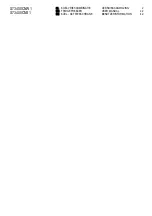
21
so observe the storage information on the pack-
aging of the merchandise.
General safety precautions
General safety precautions
General safety precautions
General safety precautions
•
Do not exceed the maximum freezing capacity.
See data under "Technical Data" and on the rat-
ing label.
•
Do not store bottles or cans. These can break
when the contents freeze – or even explode, if
they contain carbonated drinks.
•
Once products have been defrosted halfway or
completely, they should be consumed as soon as
possible and should not be frozen again, except
they have been processed to a ready meal.
•
Do not open the door in case of power failure. If
the failure does not take longer than 11115555 hours
hours
hours
hours, the
food will not be affected.
•
Do not eat food that is still frozen. Do not eat ice
cream directly from the freezer. The cold can
cause injuries in the oral cavity.
•
Touching metal parts inside the appliance can
cause symptoms similar to burns if the skin is very
sensitive.
•
Never touch frozen food with moist or wet hands.
Operating noise
Operating noise
Operating noise
Operating noise
Type of sound
Type of sound
Type of sound
Type of sound
Cause
Cause
Cause
Cause
Mumbling
Compressor during its operation
Liquid sounds
Circulation of the refrigerant
Click sounds
The temperature control turns the
compressor on or off
Disturbing
noises
Vibration of the shelves or cooling
coils
Switching
Switching
Switching
Switching off
off
off
off
To switch off the appliance
To switch off the appliance
To switch off the appliance
To switch off the appliance disconnect it from the
disconnect it from the
disconnect it from the
disconnect it from the
power supply.
power supply.
power supply.
power supply.
If the appliance is out of use for long periods:
•
Remove the appliance content.
•
Thoroughly clean the appliance (see ”Cleaning
and Maintenance”).
•
Leave open the appliance door to prevent un-
pleasant odours.
Tips for Energy saving
Tips for Energy saving
Tips for Energy saving
Tips for Energy saving
•
Disconnect the appliance from the power supply if
the appliance is not in use.
•
Do not install the appliance near stoves, heaters
or other heat sources. In case of higher ambient
temperatures, the compressor will run more fre-
quently and longer.
•
Ensure sufficient ventilation at the bottom and
rear side. Never block ventilation openings.
•
Allow warm dishes to cool down before putting
into the appliance.
•
Do not adjust the temperature colder than neces-
sary.
•
Do not open the door longer than necessary.
•
The seal of the appliance door must be complete-
ly intact, so that the door closes properly.
Cleaning
Cleaning
Cleaning
Cleaning and Maintenance
and Maintenance
and Maintenance
and Maintenance
WARNING:
WARNING:
WARNING:
WARNING:
•
Always switch off and disconnect the appliance
from the power supply before cleaning and user
maintenance.
•
Do not use steam cleaners for cleaning the appli-
ance; moisture could enter electrical components.
Risk of electric shock!
Risk of electric shock!
Risk of electric shock!
Risk of electric shock! Hot steam could damage
the plastic parts.
•
The appliance must be dry before restarting oper-
ation.
CAUTION:
CAUTION:
CAUTION:
CAUTION:
•
Do not use a wire brush or other sharp, abrasive
items.
•
Do not use any acidic or abrasive detergents.
•
Do not damage the refrigerant circuit.




































